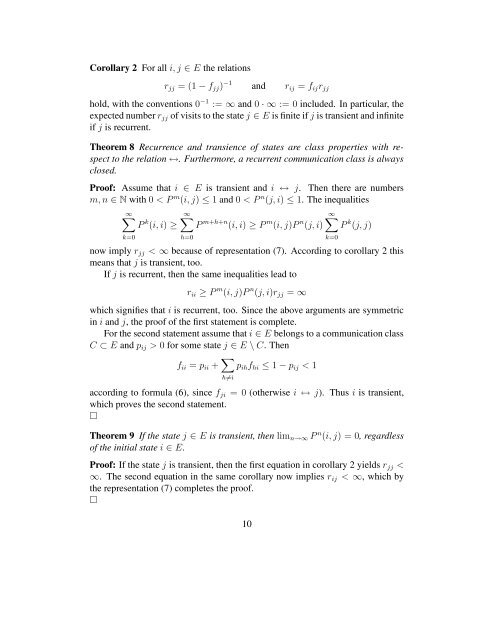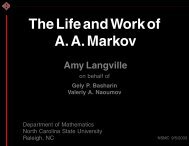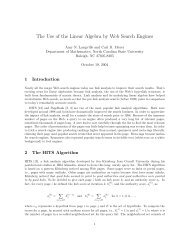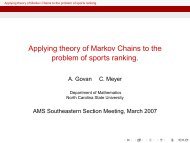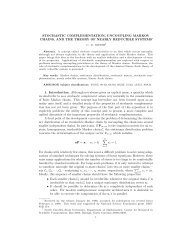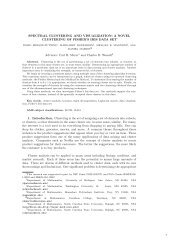Hui's reference material on Markov chains (pdf)
Hui's reference material on Markov chains (pdf)
Hui's reference material on Markov chains (pdf)
Create successful ePaper yourself
Turn your PDF publications into a flip-book with our unique Google optimized e-Paper software.
Corollary 2 For all i, j ∈ E the relati<strong>on</strong>s<br />
r jj = (1 − f jj ) −1 and r ij = f ij r jj<br />
hold, with the c<strong>on</strong>venti<strong>on</strong>s 0 −1 := ∞ and 0 · ∞ := 0 included. In particular, the<br />
expected number r jj of visits to the state j ∈ E is finite if j is transient and infinite<br />
if j is recurrent.<br />
Theorem 8 Recurrence and transience of states are class properties with respect<br />
to the relati<strong>on</strong> ↔. Furthermore, a recurrent communicati<strong>on</strong> class is always<br />
closed.<br />
Proof: Assume that i ∈ E is transient and i ↔ j. Then there are numbers<br />
m, n ∈ N with 0 < P m (i, j) ≤ 1 and 0 < P n (j, i) ≤ 1. The inequalities<br />
∞∑<br />
∞∑<br />
∞∑<br />
P k (i, i) ≥ P m+h+n (i, i) ≥ P m (i, j)P n (j, i) P k (j, j)<br />
k=0<br />
h=0<br />
now imply r jj < ∞ because of representati<strong>on</strong> (7). According to corollary 2 this<br />
means that j is transient, too.<br />
If j is recurrent, then the same inequalities lead to<br />
r ii ≥ P m (i, j)P n (j, i)r jj = ∞<br />
which signifies that i is recurrent, too. Since the above arguments are symmetric<br />
in i and j, the proof of the first statement is complete.<br />
For the sec<strong>on</strong>d statement assume that i ∈ E bel<strong>on</strong>gs to a communicati<strong>on</strong> class<br />
C ⊂ E and p ij > 0 for some state j ∈ E \ C. Then<br />
f ii = p ii + ∑ h≠i<br />
p ih f hi ≤ 1 − p ij < 1<br />
k=0<br />
according to formula (6), since f ji = 0 (otherwise i ↔ j). Thus i is transient,<br />
which proves the sec<strong>on</strong>d statement.<br />
□<br />
Theorem 9 If the state j ∈ E is transient, then lim n→∞ P n (i, j) = 0, regardless<br />
of the initial state i ∈ E.<br />
Proof: If the state j is transient, then the first equati<strong>on</strong> in corollary 2 yields r jj <<br />
∞. The sec<strong>on</strong>d equati<strong>on</strong> in the same corollary now implies r ij < ∞, which by<br />
the representati<strong>on</strong> (7) completes the proof.<br />
□<br />
10


